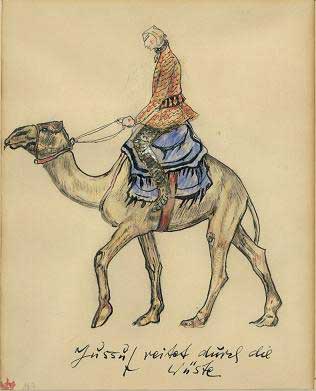Curator: Irit Salmon
Preface: Ofra Rimon
 Else Lasker-Schüler - A Poet Who PaintsThe exhibition, curated by Irit Salmon, presents Lasker-Schüler's poems alongside the drawings that she created as illustrations for her literary works in prose, poetry, and drama. (For a discussion of the link between script and illustration in her oeuvre, see Itta Shedletzky, "Script and Illustration: Hebrew Accents in Else Lasker-Schüler's Work," Massekhet 3, 2005: 79-100 [Hebrew]).
Else Lasker-Schüler - A Poet Who PaintsThe exhibition, curated by Irit Salmon, presents Lasker-Schüler's poems alongside the drawings that she created as illustrations for her literary works in prose, poetry, and drama. (For a discussion of the link between script and illustration in her oeuvre, see Itta Shedletzky, "Script and Illustration: Hebrew Accents in Else Lasker-Schüler's Work," Massekhet 3, 2005: 79-100 [Hebrew]).
The present exhibition highlights the other, less familiar facet of Lasker-Schüler's oeuvre – drawing. Habitually described as a "poet," Lasker-Schüler's drawings also manifest the artist's uniqueness. They were accentuated in an 1997 exhibition, "I and I: Drawings by Else Lasker-Schüler," at Ticho House, Jerusalem, also curated by Irit Salmon. (That exhibition subsequently traveled to the Mané-Katz Museum in Haifa.) The current exhibition, featuring works never presented before, represents, in fact, another layer in the endeavor shared by many organizations in Israel and abroad to preserve the memory and work of this gifted artist, who captivated anyone introduced to her.
What is the secret and magic of her work? A possible answer to this question was provided by the poet Lea Goldberg in her book about Avraham Ben-Yitzhak Sonne (Encounter with a Poet, Tel Aviv, 1988: 43-44): "We went to Zichel's Café. Upon entering I saw Else Lasker-Schüler sitting at one of the tables. The café was almost empty. She sat in her usual place, gray as a bat, small, poor, withdrawn... This dreadful poverty, the terrible loneliness of the great poet. Was I not also bound to be poor, solitary, and virtually outcast like her, had I not been untrue to myself every single day, had I not been unfaithful to the truth, to purity, to poetry? Was her terrible sitting not a symbol for all those lives of injustice that we, the others, who often write in resounding rhymes, have led?"
It thus seems that it was Else Lasker-Schüler's fidelity to the truth, to purity, to poetry, that spawned true art and gave rise to the numerous associations, archives, and data resources (some online) that preserve her work. Furthermore, it seems that it was Lasker-Schüler herself who made artists from the fields of literature, poetry, and the plastic arts engage in a dialogue with the woman and her work, both in her lifetime and after her death. A selection of these works is offered in the current exhibition. Our thanks to Irit Salmon, curator of the exhibition; The Jewish National and University Library, Jerusalem; The Israel Museum, Jerusalem; Bar-David Museum, Kibbutz Baram; The Open Museum, Tefen; Mishkan Le'Omanut, Museum of Art, Ein Harod; and the private collectors who were willing to lend works from their collections for the exhibition.
To Exhibition Catalogue Else Lasker-Schüler (2006)




